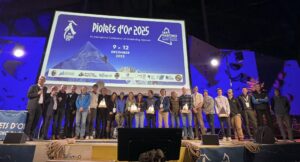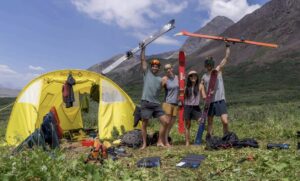Two Spanish climbers, flying under the radar, have made the first ascent of 6,824m Kharut II near K2. Another team attempted it recently without success.
One of the climbers, Koldo Zubimendi, soloed the route from advanced base camp on July 18 and recorded the videos illustrating this story. The other climber, Vicente Barcena, backed off early in the climb because he felt his pace wasn’t fast enough.
A coveted peak

Kharut I on the left and the objective, Kharut II, on the right. Photo: Koldo Zubimendi
In the first weeks of June this year, Luke Smithwick led an attempt on Kharut II, but they gave up because of high avalanche risk. One month later, the solitary Basque climbers went, chose a line, and climbed it in a day and in alpine style.
Zubimendi and Barcena had been researching the mountain for years from their home in Erandio, a small town in the Spanish Basque country. They planned to climb the peak in 2020, but the COVID pandemic forced them to postpone their plans. The chance to visit Pakistan finally came this year.

Vicente Barcena and Koldo Zubimendi on a foggy day at Concordia, from which they spoke to ExplorersWeb. Photo: Courtesy of Barcena/Zubimendi
Trying a different route
“While researching previous attempts — mainly by Japanese teams and a British expedition — I noticed that none of the teams had gone beyond 6,400m,” Zubimendi told ExplorersWeb. “The reason is that all the teams headed for a col called Sella Pass then climbed a snow dome at 6,400m. From that point, there is a sharp ridge to get to the summit that was obviously not in the right condition.”
Instead, the Basques chose to change the route. Instead of aiming for Sela Pass, they went up the west face.
The route consisted of mixed snow-ice-rock ramps of 60-65º, then over a rocky ridge.

The Kharut peaks lie northeast of K2 Base Camp along the Godwin-Austen glacier. Map: Himalaya-info.org
Near K2 Base Camp
The Kharut peaks (Kharut North, Kharut I, and Kharut II) are within one day of K2 Base Camp. Barcena and Zubimendi just went on their own, without staff. They set up a small advanced base camp in front of Kharut II’s west face.
“The approach to advanced base camp was quite tricky,” Vicente Barcena told ExplorersWeb. “That part of the Godwin-Austen glacier is really broken, and we both had some crevasse falls, because many of them were covered in fresh snow.”
At an early stage, Barcena decided to quit the climb. “My pace was not fast enough,” he said. “Before getting us both into trouble, I decided to retreat. Koldo [Zubimendi] sped up and reached the summit on his own within the day.”
The video above shows the third snow ramp Koldo Zubimendi crossed on the west face of Kharut II.
Zubimendi’s solo ascent
“On July 18, I set off from ABC and climbed the 1,200 vertical meters to the summit. Then I descended down to 6,300m, where I pitched a small bivouac tent for the night,” Zubimendi said. “On the following day, I returned to ABC.”
Koldo Zubimendi’s bivouac on the way down from the summit.
Following are the details of the climb, as told by Koldo Zubimendi:
The mountain was covered in fresh snow but there were still some mixed sections on the west face’s ramps. At about mid-face, the snow was so deep that I couldn’t progress, so I had to traverse south until I climbed a ridge that led to the summit, with some M4 sections.
The final sections of the ridge leading to the summit of Kharut II. Photo: Koldo Zubimendi
The snow that covered some parts of the ridge was so rotten that I chose to advance by cleaning it with the ice axe — it was some 30cm thick — and progressed on the rock below. It took so long, but it was the safest option. In fact, on the descent I avoided that ridge, which was too difficult to downclimb. Instead, I climbed down on ice and snow, leaning on the two ice axes and the crampon points.
The summit is a 10-meter-high rocky tower, and the rock is also of poor quality, very brittle. I started climbing it without gloves, and two holds broke between my fingers. I had to look for a narrow snow gully on the right, with an exposed pass across an overhanging block. I secured myself to it and rose two meters in order to be able to reach the highest point with my head. [In the video below, the climber narrates the situation in his native Basque.] I didn’t stand on top: It was too risky and the ice axes didn’t hold in the rotten snow.
We were able to contact the climbers thanks to Luis Soriano, who is currently filming for a Russian team on K2. Soriana told us from Base Camp about the first ascent. Otherwise, it might have passed unnoticed. The peak’s location made it easy for a two-person independent team.
Speaking of first ascents, for those looking for ideas: Kharut I is still unclimbed.







